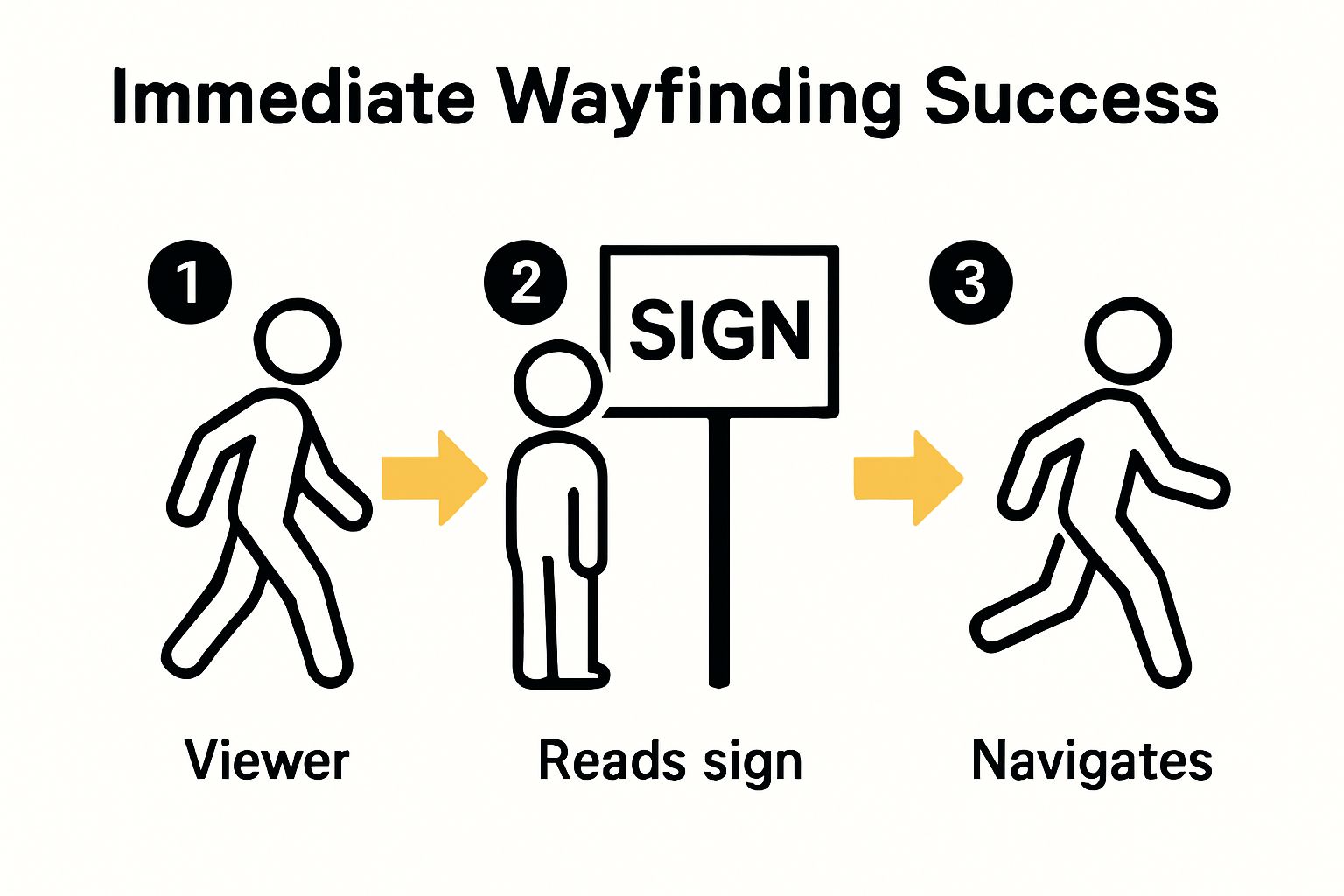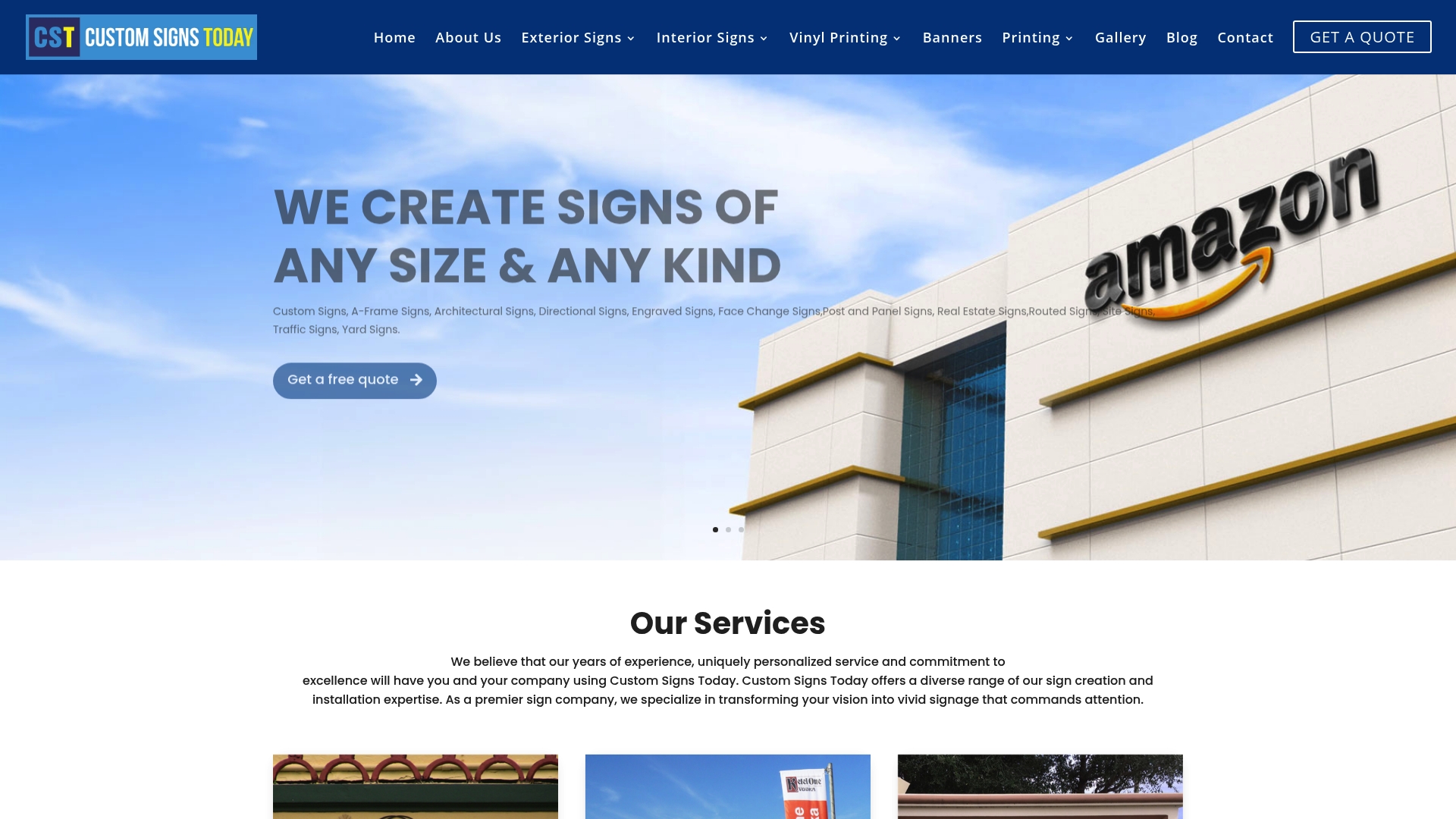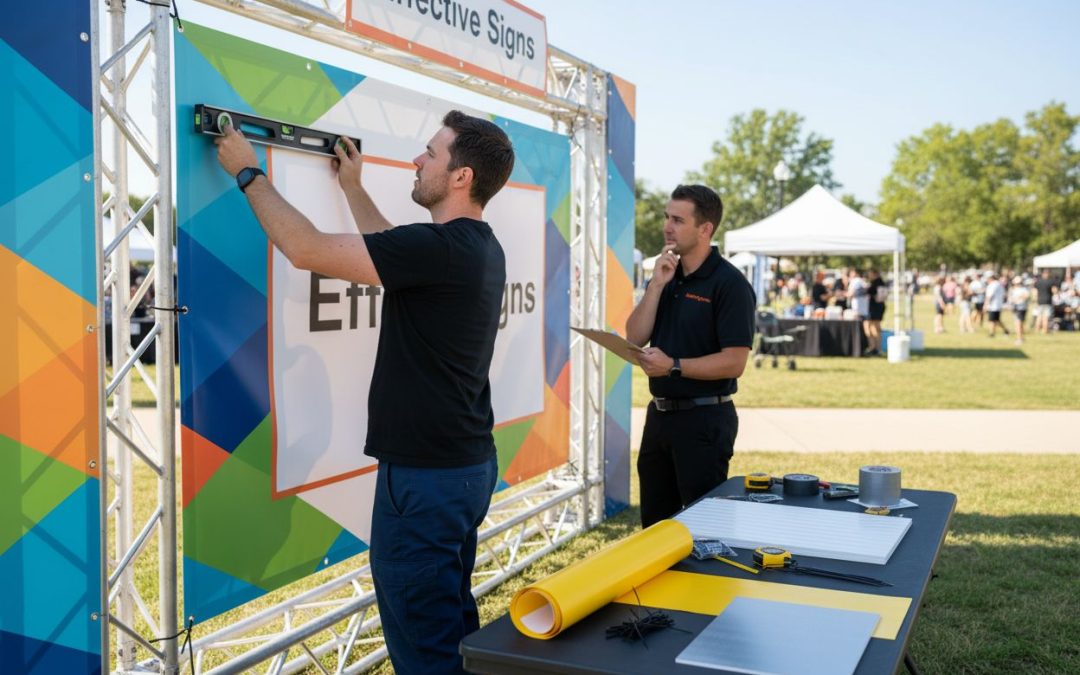Outdoor event signage can make or break the attendee experience and research shows that well-placed signs can improve event navigation by up to 50 percent. Most people assume flashy graphics or fancy fonts will grab attention right away. The real secret is knowing your audience and matching every sign to a specific goal long before you start the design.
Table of Contents
- Step 1: Identify Your Audience And Goals
- Step 2: Choose The Right Sign Type And Materials
- Step 3: Design Eye-Catching Signage
- Step 4: Install Signs In Strategic Locations
- Step 5: Test Visibility And Accessibility
- Step 6: Evaluate Effectiveness Post-Event
Quick Summary
| Key Point | Explanation |
|---|---|
| 1. Identify Audience and Goals | Understand your audience’s characteristics and define clear objectives for your signage. |
| 2. Choose Appropriate Sign Type | Select materials and types of signs that suit environmental conditions and event duration. |
| 3. Design for Visibility and Clarity | Create engaging designs with readable fonts and high contrast for maximum impact. |
| 4. Strategically Install Signs | Place signs where they can be easily seen and accessed by attendees in high-traffic areas. |
| 5. Evaluate Signage Effectiveness Post-Event | Collect feedback and analyze sign performance to improve future event communication strategies. |
Step 1: Identify Your Audience and Goals
Successful outdoor event signage starts with a crystal clear understanding of who you are communicating with and what you want to achieve. Audience identification and goal setting form the critical foundation of any effective signage strategy.
Begin by conducting a comprehensive audience analysis that goes beyond basic demographics. Consider the specific characteristics of the people who will be interacting with your signs. Are they potential customers at a trade show, attendees at a conference, or local community members at a public event? Understanding their age range, professional background, interests, and likely information needs will dramatically influence your signage design and messaging.
Goal setting requires precise articulation of what you want your signs to accomplish. Do you want to provide directional information, create brand awareness, generate excitement about an event, or drive specific attendee actions? Each objective demands a different visual and communicative approach. For instance, wayfinding signs require clarity and simplicity, while promotional signs need to be visually engaging and emotionally compelling.
Take time to document your specific objectives. A marketing event might aim to generate leads, while a community festival sign could focus on creating a welcoming atmosphere. By clearly defining these goals, you create a strategic framework that guides every subsequent design decision.
Consider potential challenges in your communication. What barriers might prevent your audience from understanding or engaging with your signs? These could include language differences, accessibility needs, visual complexity, or environmental distractions. Anticipating and addressing these potential obstacles ensures your signage remains effective across diverse scenarios.
Verify your audience and goal alignment by asking critical questions:
- Does the sign’s message directly address the intended audience?
- Will the design and content resonate with their expectations and interests?
- Can the sign be easily understood within its intended environment?
According to the U.S. Small Business Administration, thorough market research is fundamental to creating targeted communication strategies. By investing time in understanding your audience and crystallizing your objectives, you set the stage for outdoor event signage that truly connects and communicates.
Step 2: Choose the Right Sign Type and Materials
Selecting the appropriate sign type and materials is a critical decision that directly impacts the effectiveness and durability of your outdoor event signage. Different environments and event purposes demand specific sign solutions that can withstand various conditions while communicating your message clearly.
Start by evaluating the specific requirements of your event environment. Outdoor signs must contend with multiple challenges including wind, rain, sunlight, temperature fluctuations, and potential physical interactions. Lightweight materials like corrugated plastic work well for short term events, while aluminum or metal signs provide superior durability for longer installations. Weatherproof materials are not just a recommendation but a necessity for reliable outdoor communication.
Consider the visual communication goals alongside material selection. Vinyl banners offer vibrant color reproduction and flexibility for temporary events, whereas rigid panel signs provide a more professional and permanent appearance. Some events might require multiple sign types to achieve comprehensive communication. A trade show, for instance, might need large backdrop signs, directional signage, and smaller informational panels.
The physical location of your signs plays a crucial role in material selection. Signs near coastal areas need corrosion resistant materials, while mountainous or high wind regions require additional structural reinforcement. Weight, mounting options, and potential wind resistance become critical technical considerations that extend beyond aesthetic preferences.
Verify your sign type and material selection by asking key diagnostic questions:
- Will the selected material survive the expected environmental conditions?
- Does the sign material align with the event’s duration and communication objectives?
- Can the sign be easily transported, installed, and removed?
For comprehensive guidance on exterior sign options, professional consultation can help navigate the complex landscape of material selection. Understanding the nuanced relationship between sign type, material, and environmental context ensures your outdoor event signage remains functional, attractive, and impactful.
Below is a comparison of common outdoor event sign materials and types to help you match your selection with event needs and environmental challenges.
| Sign Material/Type | Best For | Durability | Visibility | Notes |
|---|---|---|---|---|
| Corrugated Plastic | Short-term outdoor events | Moderate | Good | Lightweight, easy to move |
| Aluminum/Metal | Long-term/permanent installations | High | Very Good | Weatherproof and durable |
| Vinyl Banner | Temporary, promotional signage | Moderate | High | Flexible, vibrant colors |
| Rigid Panel | Professional, permanent signage | High | Good | Sturdy, lends a polished appearance |
| Weatherproof Composite | All-weather outdoor events | High | Good | Resistant to corrosion and elements |
| Foam Board | Indoor or very brief outdoor use | Low | Fair | Not suitable for wind or rain |
| Mesh Banner | Windy outdoor environments | Moderate | High | Allows wind to pass through |
Remember that material choice is not just about durability but about creating a visual communication tool that effectively represents your event’s brand and message. Thoughtful selection transforms signs from mere informational objects into powerful engagement instruments.
Step 3: Design Eye-Catching Signage
Creating visually compelling signage is an art form that combines strategic communication with aesthetic appeal. Design is the critical bridge between information and audience engagement, transforming ordinary signs into powerful communication tools that capture attention and convey messages instantly.
Start by establishing a visual hierarchy that guides the viewer’s eye through the sign’s content. The most critical information should be largest and most prominent, using font sizes and weights strategically. Select typography that is both readable from a distance and aligned with your event’s overall aesthetic. Sans serif fonts typically offer superior legibility for outdoor signage, with bold lettering ensuring visibility across different lighting conditions and viewing distances.
Color selection plays a pivotal role in sign design. High contrast color combinations dramatically increase readability and visual impact. Consider using your brand or event colors strategically, but prioritize visibility over pure aesthetic preferences. Dark text on light backgrounds or vice versa creates the most effective visual communication. Avoid overly complicated color schemes that might distract from your core message.
Graphic elements should complement rather than overwhelm your textual content. Use simple, clean illustrations or icons that quickly communicate concepts. Negative space is your ally in design – overcrowded signs become difficult to comprehend at a glance. Think of your sign as a visual billboard that needs to communicate its message within seconds of viewer interaction.
Verify your sign design effectiveness by asking critical assessment questions:
- Can the sign be read and understood from the intended viewing distance?
- Does the design align with the event’s professional image and communication goals?
- Are the most important elements immediately visible?
According to the American Psychological Association, legibility and visual impact are fundamental to effective signage. By thoughtfully balancing design elements, you transform signs from mere information displays into compelling communication instruments that engage and inform your audience.

For more insights into creating impactful event signage, professional design consultation can provide nuanced strategies tailored to your specific event requirements.
Step 4: Install Signs in Strategic Locations
Successful sign placement transforms informational materials from passive objects into dynamic communication tools. Strategic positioning determines whether your signs will actually reach and engage your intended audience. This critical step requires careful analysis of event space, attendee movement patterns, and potential visual obstacles.
Begin by conducting a comprehensive site walkthrough, mapping out key areas where attendees will naturally congregate or require guidance. Intersections, entry points, and high traffic zones represent prime real estate for sign placement. Consider sightlines from multiple angles, ensuring signs are visible without requiring people to stop or strain their vision. Height becomes a crucial factor – signs should be positioned at eye level for maximum readability, with larger signs potentially mounted slightly higher to capture broader attention.
Environmental context plays a significant role in sign installation. Physical obstructions like trees, architectural features, or existing structures can block visibility. Account for natural lighting conditions, understanding how sunlight might create glare or shadows that diminish sign legibility. In outdoor settings, signs need additional consideration for wind resistance, potential terrain challenges, and stability requirements. Temporary events might require lightweight mounting solutions, while more permanent installations demand robust anchoring mechanisms.
Technical preparation is equally important. Bring appropriate installation tools including levels, measuring tape, mounting hardware, and safety equipment. Some signs might require professional installation, particularly those involving complex mounting or electrical components. Always prioritize safety and structural integrity over aesthetic preferences.
Verify your sign placement strategy by examining these critical assessment points:
- Are signs clearly visible from primary approach paths?
- Can signs be read without obstruction or visual interference?
- Do the signs logically guide attendees through the event space?
According to urban design research from MIT’s Senseable City Lab, spatial communication depends on strategic positioning that anticipates human movement patterns. By thoughtfully mapping your sign locations, you transform physical spaces into intuitive, navigable environments.
For additional insights into strategic sign placement, professional consultation can provide nuanced strategies tailored to your specific event layout and communication objectives.
Step 5: Test Visibility and Accessibility
Testing sign visibility and accessibility transforms your carefully designed signage from theoretical concept to practical communication tool. Comprehensive testing ensures your signs actually perform their intended function across diverse viewing conditions and audience needs. This critical validation step goes beyond simple visual assessment, demanding a holistic approach to effective communication.
Begin with a comprehensive visibility assessment by conducting systematic walkthrough tests at different times of day. Simulate various lighting conditions including bright sunlight, overcast environments, and potential evening illumination. Signs must remain legible and clear across these dynamic scenarios. Use a testing methodology that involves walking the entire event space from multiple perspectives, carefully documenting how signs appear from different angles, distances, and approach paths.
Accessibility represents a crucial dimension of sign effectiveness that extends far beyond visual clarity. Consider the diverse needs of all potential audience members, including individuals with visual impairments, mobility challenges, or different height perspectives. Signs should provide clear information that can be understood through multiple sensory channels.
Use this checklist table to verify your sign installations for both visibility and accessibility before the event begins.
| Checkpoint | What to Verify | Why It Matters |
|---|---|---|
| Daytime Visibility | Sign can be read during bright sunlight | Ensures no glare or faded colors |
| Evening/Low Light Readability | Content legible in low light or with artificial lighting | Maintains communication after sunset |
| Viewing Distance | Text and graphics visible from intended approach distances | Prevents missed information |
| Obstruction-Free Placement | No trees, structures, or obstacles block sign | Direct line of sight for attendees |
| Height Accessibility | Sign is readable by wheelchair users and children | Promotes inclusivity for all guests |
| Color Contrast | High contrast between background and text | Improves legibility for everyone |
| Structural Stability | Sign is secure and resists wind or weather | Prevents damage and safety issues |
Technical testing requires systematic evaluation. Bring measuring tools to verify text legibility distances, use color contrast measurement apps to validate readability, and consider photographing signs from various perspectives to objectively assess their performance. Rigorous testing transforms good sign design into exceptional communication tools.

Verify your sign effectiveness through these critical assessment criteria:
- Can signs be read clearly from intended viewing distances?
- Are signs accessible to individuals with different physical capabilities?
- Do signs provide clear, unambiguous information in various lighting conditions?
According to universal design research from the Nielsen Norman Group, effective communication requires considering diverse user needs and perspectives. By implementing comprehensive testing protocols, you ensure your signs communicate effectively across different audience segments.
For additional guidance on creating universally accessible signage, professional consultation can provide nuanced strategies tailored to your specific event requirements.
Step 6: Evaluate Effectiveness Post-Event
Post event signage evaluation transforms your experience into a learning opportunity, providing critical insights that enhance future communication strategies. Systematic assessment turns individual event challenges into comprehensive organizational knowledge, creating a continuous improvement framework for your signage approach.
Initiate your evaluation process by collecting multifaceted feedback from multiple perspectives. Engage event staff, attendees, and key stakeholders through structured surveys, direct interviews, and observational notes. Document specific interactions with signage, noting instances of confusion, successful navigation, or unexpected user behaviors. Photographic evidence can provide additional context, capturing real world sign performance in ways verbal descriptions might miss.
Quartitative and qualitative data collection becomes crucial in understanding sign effectiveness. Track metrics such as average time spent reading signs, frequency of directional inquiries, and overall attendee movement patterns. Digital tools like heat mapping or video analysis can offer sophisticated insights into how people interact with your signage in real time. Raw data transforms subjective impressions into objective performance measurements.
Consider the comprehensive performance landscape beyond immediate visual communication. Evaluate how signs contributed to broader event objectives like attendee satisfaction, brand perception, and operational efficiency. Signs are not standalone objects but integrated communication tools that play a strategic role in overall event experience.
Verify your post event evaluation by addressing these critical assessment points:
- Did signs fulfill their intended communication objectives?
- What unexpected challenges or successes emerged during the event?
- How can future signage design be improved based on current insights?
According to user experience research from Stanford University, systematic post implementation review is fundamental to developing increasingly sophisticated communication strategies. By treating each event as a learning opportunity, you continually refine your approach.
For deeper insights into event communication optimization, professional consultation can help translate your evaluation findings into actionable design improvements for future events.
Transform Your Outdoor Event with Custom Signs That Do More Than Get Noticed
Are you struggling to turn your carefully planned signage strategy into real results at your next outdoor event? From selecting durable materials to ensuring eye-catching designs and strategic placement, each step demands expertise and attention to detail. If you want to avoid the stress of unclear messaging, ineffective wayfinding, or signage that does not withstand the weather, you need a partner who understands the importance of both quality and communication.
Explore Solutions for Outdoor Event Signage

Take your event to the next level with signage designed just for you. At Custom Signs Today, we specialize in high-impact, weather-ready signs that are tailored to your event goals, your audience, and your brand. Whether you need banners that stand out, directions that guide attendees with ease, or promotional signs that create excitement, our team can help you make a lasting impression. Let us show you how easy it is to get professional signage that supports every step in your event journey. Ready to start now? Contact us today for your custom quote and see your event vision come to life.
Frequently Asked Questions
How can I identify my target audience for outdoor event signage?
To identify your target audience, conduct a comprehensive analysis considering demographics, interests, and information needs. Engage with potential attendees or stakeholders, and gather insights to inform your design and messaging strategy.
What goals should I set for my outdoor event signage?
Clearly articulate the objectives you want your signage to achieve, such as generating brand awareness, providing directional information, or encouraging specific actions. Write down these goals to guide your design process and ensure effective communication.
Which materials are best for outdoor event signs?
Select materials based on environmental conditions and event duration. For instance, choose weatherproof materials like aluminum for longer installations and lightweight options like corrugated plastic for temporary events.
How can I ensure my signs are visually appealing and easy to read?
Establish a clear visual hierarchy by making the most critical information largest and using high contrast color combinations for better readability. Test your design for legibility from various distances to ensure it captures attention effectively.
What steps should I take to test the visibility and accessibility of my signs?
Conduct systematic walkthroughs at different times of day to assess visibility under various lighting conditions. Additionally, ensure that signs are accessible to individuals with different physical capabilities by positioning them at appropriate heights and using clear, contrasting colors.
How can I evaluate the effectiveness of my outdoor event signage after the event?
Collect feedback from attendees and staff through structured surveys and observations. Analyze both qualitative and quantitative data, such as time spent reading signs and directional inquiries, to refine your approach for future events.

